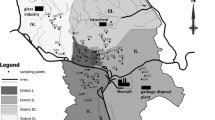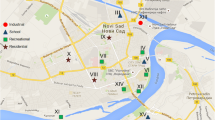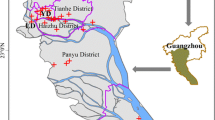Abstract
Soil samples from school playground of Gwangju City were analyzed for 16 polycyclic aromatic hydrocarbons (PAHs), and the soil contamination status and the potential cancer risk for students and adults were investigated. Soil samples were collected from 57 sites from 5 districts of Gwangju City in the summer of 2013. Regardless of the sampling site, the ∑PAHs concentrations ranged from 13.2 to 145.5 ng/g (mean 51.2 ng/g). Four and five-ring PAHs were predominant in the soil samples while the fraction of two-ring PAHs was the lowest. Seven carcinogenic PAHs contributed ~ 55% of ∑PAHs in school playground soils. The benzo[a]pyrene (46.4%) and dibenz[a,h]anthracene (41.2%) were the major contributors to toxic equivalent quantity. The strong correlation between carcinogenic PAHs suggested that they originated from the same source either vehicular emission or coal combustion, because they are markers of these pollution sources. The mean cancer risk for students (3.61 × 10−7) and adults (8.41 × 10−6) was in the U.S. EPA safety range (< 10−6).





Similar content being viewed by others
References
Albanese S et al (2014) Polycyclic aromatic hydrocarbons in the soils of a densely populated region and associated human health risks: the Campania Plain (Southern Italy) case study. Environ Geochem Health 37:1–20
Bandowe BAM, Nkansah MA (2016) Occurrence, distribution and health risk from polycyclic aromatic compounds (PAHs, oxygenated-PAHs and azaarenes) in street dust from a major West African Metropolis. Sci Total Environ 553:439–449
Bortey-Sam N et al (2014) Occurrence, distribution, sources and toxic potential of polycyclic aromatic hydrocarbons (PAHs) in surface soils from the Kumasi Metropolis, Ghana. Sci Total Environ 496:471–478
Cao Z, Wang Y, Ma Y, Xu Z, Shi G, Zhuang Y, Zhu T (2005) Occurrence and distribution of polycyclic aromatic hydrocarbons in reclaimed water and surface water of Tianjin, China. J Hazard Mater 122:51–59
Cao H, Chao S, Qiao L, Jiang Y, Zeng X, Fan X (2017) Urbanization-related changes in soil PAHs and potential health risks of emission sources in a township in Southern Jiangsu, China. Sci Total Environ 575:692–700
Chen S-C, Liao C-M (2006) Health risk assessment on human exposed to environmental polycyclic aromatic hydrocarbons pollution sources. Sci Total Environ 366:112–123
Chen M, Huang P, Chen L (2013) Polycyclic aromatic hydrocarbons in soils from Urumqi, China: distribution, source contributions, and potential health risks. Environ Monit Assess 185:5639–5651
Dahle S, Savinov VM, Matishov GG, Evenset A, Næs K (2003) Polycyclic aromatic hydrocarbons (PAHs) in bottom sediments of the Kara Sea shelf, Gulf of Ob and Yenisei Bay. Sci Total Environ 306:57–71
Dong TTT, Lee B-K (2009) Characteristics, toxicity, and source apportionment of polycylic aromatic hydrocarbons (PAHs) in road dust of Ulsan, Korea. Chemosphere 74:1245–1253
Franco CFJ, de Resende MF, de Almeida Furtado L, Brasil TF, Eberlin MN, Netto ADP (2017) Polycyclic aromatic hydrocarbons (PAHs) in street dust of Rio de Janeiro and Niterói, Brazil: particle size distribution, sources and cancer risk assessment. Sci Total Environ 599:305–313
Halek F, Nabi G, Kavousi A (2008) Polycyclic aromatic hydrocarbons study and toxic equivalency factor (TEFs) in Tehran, IRAN. Environ Monit Assess 143:303–311
Harrison RM, Smith DJT, Luhana L (1996) Source apportionment of atmospheric polycyclic aromatic hydrocarbons collected from an urban location in Birmingham, UK. Environ Sci Technol 30:825–832
IARC (1987) IARC monographs on the evaluation of the carcinogenic risk of chemicals to humans. In: Overall evaluation of carcinogenity: an updating of IAPC monographs. International Agency for Research on Cancer, Lyon
Islam MN, Park M, Jo Y-T, Nguyen XP, Park S-S, Chung S-Y, Park J-H (2017) Distribution, sources, and toxicity assessment of polycyclic aromatic hydrocarbons in surface soils of the Gwangju City, Korea. J Geochem Explor 180:52–60
Jiang Y-F, Wang X-T, Wang F, Jia Y, Wu M-H, Sheng G-Y, Fu J-M (2009) Levels, composition profiles and sources of polycyclic aromatic hydrocarbons in urban soil of Shanghai, China. Chemosphere 75:1112–1118
Karaca G (2016) Spatial distribution of polycyclic aromatic hydrocarbon (PAH) concentrations in soils from Bursa, Turkey. Arch Environ Contam Toxicol 70:406–417
Keith L, Telliard W (1979) ES&T special report: priority pollutants: I-a perspective view. Environ Sci Technol 13:416–423
Khalili NR, Scheff PA, Holsen TM (1995) PAH source fingerprints for coke ovens, diesel and gasoline engines, highway tunnels, and wood combustion emissions. Atmos Environ 29:533–542
Kwon H-O, Choi S-D (2014) Polycyclic aromatic hydrocarbons (PAHs) in soils from a multi-industrial city, South Korea. Sci Total Environ 470–471:1494–1501
Larsen RK, Baker JE (2003) Source apportionment of polycyclic aromatic hydrocarbons in the urban atmosphere: a comparison of three methods. Environ Sci Technol 37:1873–1881
Liu A, Lang Y, Xue L, Liu J (2009) Ecological risk analysis of polycyclic aromatic hydrocarbons (PAHs) in surface sediments from Laizhou Bay. Environ Monit Assess 159:429–436
Melnyk A, Dettlaff A, Kuklińska K, Namieśnik J, Wolska L (2015) Concentration and sources of polycyclic aromatic hydrocarbons (PAHs) and polychlorinated biphenyls (PCBs) in surface soil near a municipal solid waste (MSW) landfill. Sci Total Environ 530–531:18–27
Nguyen TC et al (2014) Polycyclic aromatic hydrocarbons in road-deposited sediments, water sediments, and soils in Sydney, Australia: comparisons of concentration distribution, sources and potential toxicity. Ecotoxicol Environ Saf 104:339–348
Rajpara RK, Dudhagara DR, Bhatt JK, Gosai HB, Dave BP (2017) Polycyclic aromatic hydrocarbons (PAHs) at the Gulf of Kutch, Gujarat, India: occurrence, source apportionment, and toxicity of PAHs as an emerging issue. Mar Pollut Bull 119:231–238
Rogge WF, Mazurek MA, Hildemann LM, Cass GR, Simoneit BRT (1993) Quantification of urban organic aerosols at a molecular level: identification, abundance and seasonal variation. Atmos Environ Part A Gen Topics 27:1309–1330
Singh DP, Gadi R, Mandal TK (2012) Levels, sources, and toxic potential of polycyclic aromatic hydrocarbons in urban soil of Delhi, India. Hum Ecol Risk Assess Int J 18:393–411
Stajic JM, Milenkovic B, Pucarevic M, Stojic N, Vasiljevic I, Nikezic D (2016) Exposure of school children to polycyclic aromatic hydrocarbons, heavy metals and radionuclides in the urban soil of Kragujevac City, Central Serbia. Chemosphere 146:68–74
Sun C, Zhang J, Ma Q, Zhang F, Chen Y (2016) Risk assessment of polycyclic aromatic hydrocarbons (PAHs) in sediments from a mixed-use reservoir. Hum Ecol Risk Assess An Int J 22:447–459
Tobiszewski M, Namieśnik J (2012) PAH diagnostic ratios for the identification of pollution emission sources. Environ Pollut 162:110–119
USEPA (2015) Regional screening levels for chemical contaminants at superfund sites. Regional screening table. User’s guide
Wang W, M-j Huang, Kang Y, H-s Wang, Leung AOW, Cheung KC, Wong MH (2011) Polycyclic aromatic hydrocarbons (PAHs) in urban surface dust of Guangzhou, China: status, sources and human health risk assessment. Sci Total Environ 409:4519–4527
Wang C, Wu S, Zhou S, Shi Y, Song J (2017a) Characteristics and source identification of polycyclic aromatic hydrocarbons (PAHs) in urban soils: a review. Pedosphere 27:17–26
Wang J, Zhang X, Ling W, Liu R, Liu J, Kang F, Gao Y (2017b) Contamination and health risk assessment of PAHs in soils and crops in industrial areas of the Yangtze River Delta region, China. Chemosphere 168:976–987
Yang D et al (2013) Levels, sources and potential risks of polycyclic aromatic hydrocarbons (PAHs) in multimedia environment along the Jinjiang River mainstream to Quanzhou Bay, China. Mar Pollut Bull 76:298–306
Yu G, Zhang Z, Yang G, Zheng W, Xu L, Cai Z (2014) Polycyclic aromatic hydrocarbons in urban soils of Hangzhou: status, distribution, sources, and potential risk. Environ Monit Assess 186:2775–2784
Yuan H, Li T, Ding X, Zhao G, Ye S (2014) Distribution, sources and potential toxicological significance of polycyclic aromatic hydrocarbons (PAHs) in surface soils of the Yellow River Delta, China. Mar Pollut Bull 83:258–264
Yunker MB, Macdonald RW, Vingarzan R, Mitchell RH, Goyette D, Sylvestre S (2002) PAHs in the Fraser River basin: a critical appraisal of PAH ratios as indicators of PAH source and composition. Org Geochem 33:489–515
Zakaria MP, Takada H, Tsutsumi S, Ohno K, Yamada J, Kouno E, Kumata H (2002) Distribution of polycyclic aromatic hydrocarbons (PAHs) in rivers and estuaries in Malaysia: a widespread input of petrogenic PAHs. Environ Sci Technol 36:1907–1918
Zhang P, Chen Y (2017) Polycyclic aromatic hydrocarbons contamination in surface soil of China: a review. Sci Total Environ 605:1011–1020
Zhang Y, Wang J (2011) Distribution and source of polycyclic aromatic hydrocarbons (PAHs) in the surface soil along main transportation routes in Jiaxing City, China. Environ Monit Assess 182:535–543
Zhang W, Zhang S, Wan C, Yue D, Ye Y, Wang X (2008) Source diagnostics of polycyclic aromatic hydrocarbons in urban road runoff, dust, rain and canopy throughfall. Environ Pollut 153:594–601
Zhang J et al (2013) Effects of pollution sources and soil properties on distribution of polycyclic aromatic hydrocarbons and risk assessment. Sci Total Environ 463–464:1–10
Acknowledgements
The authors acknowledge a Grant-in-aid (No. 13-2-60-61) for research from Gwangju Green Environment Center, Korea.
Author information
Authors and Affiliations
Corresponding author
Electronic supplementary material
Below is the link to the electronic supplementary material.
Rights and permissions
About this article
Cite this article
Islam, M.N., Jo, YT., Chung, SY. et al. Assessment of Polycyclic Aromatic Hydrocarbons in School Playground Soils in Urban Gwangju, South Korea. Arch Environ Contam Toxicol 74, 431–441 (2018). https://doi.org/10.1007/s00244-017-0467-9
Received:
Accepted:
Published:
Issue Date:
DOI: https://doi.org/10.1007/s00244-017-0467-9




